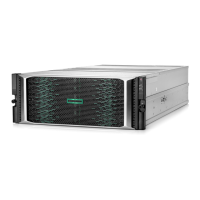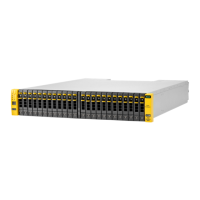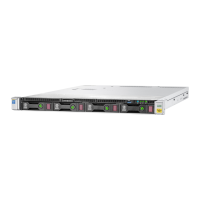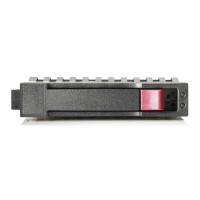Do you have a question about the HP HPE Alletra 2140 and is the answer not in the manual?
Preparation for installing storage array, covering network topology, IP addresses, and subnets.
Describes network topology options like one shared, two dedicated, advanced, or dual fabric Fibre Channel.
Separates management and data traffic into two subnets for security and high availability.
Provides flexibility for dedicated management or I/O flow with advanced multipath requirements.
Uses two Fibre Channel switches for redundant paths and management via Ethernet.
Explains the purpose of IP addresses for communication, management, and data.
Lists required firewall rules for Storage SAN to communicate with specific ports.
Defines subnets as logical subdivisions of a network, specified by IP address and netmask.
Segregates network traffic into subnets for management, data, or both.
Groups host and array data IP addresses within a subnet for performance.
Sets of two Ethernet connections, one from each controller, to the network switch for redundancy.
Sets of two Fibre Channel data connections, one from each controller, to the switch.
Details the number and types of ports available on array models.
Lists prerequisites and required hardware for installing the array.
Step-by-step instructions for unpacking and installing outer rail assemblies onto the rack.
Instructions for safely sliding the chassis into the installed rail assemblies.
Securing the chassis to the rack using handles and thumbscrews.
Connecting network cables for management and data based on desired topology.
Configuration where management and data paths share the same subnet or network.
Configuration separating management and data paths on different subnets or networks.
Configuration for data and management paths on different subnets for advanced I/O.
Configuration for managing multiple arrays as a group on the same subnets.
Steps to connect power cables to the expansion shelf and verify power.
Cloud services offering consistent experience, combining agility with governance and compliance.
Cloud application for simplifying data infrastructure management and delivering data services.
Steps to enable cloud management, including software subscriptions and account creation.
Activating software subscriptions via email link and HPE Software Center.
Creating a user account for HPE GreenLake Common Cloud Services.
Creating an HPE GreenLake company account, defaulting to super admin.
Adding the Data Services Cloud Console application to an HPE GreenLake account.
Assigning necessary permissions to a user account for Data Services Cloud Console access.
Adding and assigning the storage array to Data Services Cloud Console for management.
Resolving connectivity issues between the array and the cloud console.
Downloading the latest HPE Storage Toolkit for Windows from HPE InfoSight.
Installing the HPE Storage Toolkit on a Windows client for array setup.
Using HPE Storage Setup Manager to create a new group from an uninitialized array.
Establishing a serial connection for initial setup using the CLI.
Completing the initial setup process using the Command Line Interface (CLI).
Post-installation tasks including configuration, setup, and connections.
Information on Windows Toolkit features for application-consistent snapshots and data connections.
HPE storage array integration with VMware, including vStorage APIs, vCenter plugin, and VASA Provider.
Guidance for setting up MPIO in a generic Linux environment.
Managing network settings, performance policies, volumes, and groups via the OS.
Information on updating the operating system and hardware components.
Procedures for replacing components like controllers, power supplies, or drives.
Information on downloading manuals from the HPE InfoSight portal.
HPE Support contact information for troubleshooting and guidance.
Description of the front panel of the array, including drive bays and bezel.
Description of the rear panel, including controllers, power supplies, and cabling connections.
Explanation of drive operation and drive fault LEDs.
Description of the power supply LED status indicators.
Location and content of the system information label on the chassis rear.
Steps to find the array serial number using the Graphical User Interface.
Steps to find the array serial number using the Command Line Interface.
Explanation of normal Active/Standby controller status and when to contact support.
Verifying array model, OS version, and controller states via GUI.
Verifying array model, OS version, and controller states via CLI.
Steps to shut down the array and expansion shelves via the Graphical User Interface.
Steps to shut down the array using the Command Line Interface (CLI).
Procedure for restarting the array using the CLI.
Location of array front LEDs and their general description.
Lists requirements for installing each expansion shelf.
Step-by-step instructions for unpacking and installing outer rail assemblies for expansion shelves.
Steps to connect power cables to the expansion shelf and verify power.
Steps to install OCP cards in the standby controller before connecting an expansion shelf.
Shows slot designations for the HPE Alletra 2140 expansion shelf front panel.
Describes rear panel components including expanders and power supplies.
Details the front LEDs for power, expander ID, health, and power status.
Explanation of drive operation and drive fault LEDs for expansion shelves.
Procedures for maintaining drives, including SSDs, arrays, and expansion shelves.
Explains how the array manages failed drives using spare space and rebuild processes.
Indicators of a failed solid state drive (SSD).
Procedure to replace SSDs in HPE storage arrays or expansion shelves.
Procedure to replace a controller in the HPE storage array.
Checking controller operating state (Active/Standby) via GUI.
Checking controller operating state (Active/Standby) via CLI.
Procedure to replace an expander in an expansion shelf.
Procedure to replace a failed AC power supply unit (PSU) on storage arrays or expansion shelves.
Replacing AC PSUs with DC PSUs on HPE storage arrays.
Procedure to replace a failed DC power supply unit (PSU).
Procedure to replace the chassis of an HPE storage array or expansion shelf.
Procedure to add SSDs to increase capacity on HPE storage arrays or expansion shelves.
Procedure to upgrade NICs, HBAs, or SCM cards in HPE storage arrays.
Procedure to upgrade controllers in an HPE storage array.
Installing 1600W power supplies for controller upgrades.
Rules for cabling power supplies for redundancy with underpowered PSUs.
General and model-specific hardware specifications including dimensions and weight.
Environmental specifications for temperature, humidity, and altitude.
Electrical requirements for power supplies and connectors for various HPE Alletra models.
Links to latest specifications for HPE Alletra 6000 storage arrays.
Information on optical fiber transceivers (SFP+, SFP28, QSFP28).
Detailed specifications for 10GbE SFP+ transceivers.
Detailed specifications for 25GbE SFP28 transceivers.
Detailed specifications for 32Gb Fibre Channel SFP+ transceivers.
Detailed specifications for 100GbE QSFP28 transceivers.
Cable grades and maximum link distances for various Ethernet and Fibre Channel cables.
Identifies volatile devices and procedures to clear them.
Identifies non-volatile devices and procedures to clear them.
Describes checking storage array and expansion shelf temperatures to prevent overheating.
Explains the role of fans and temperature sensors in maintaining system operation.
Details results based on external temperature readings.
Recommended actions for temperature alert messages.
Checking system temperature via the Graphical User Interface.
Checking system temperature via the Command Line Interface.
Describes all regulatory warnings applicable to HPE storage arrays.
Safety warnings specific to HPE storage arrays.
Basic electrical safety precautions for protection and to prevent damage.
Safety precautions related to AC power supplies and input voltage.
Safety precautions for DC supply circuits and earthing conductors.
Precautions to avoid damage from electrostatic discharge (ESD).
Information on the super-capacitor for NVDIMM power.
| Model | HPE Alletra 2140 |
|---|---|
| Category | Storage |
| Form Factor | 2U |
| Drive Bays | 24 |
| Controllers | Dual controllers |
| Data Reduction | Deduplication and Compression |
| Availability | 99.9999% |
| Drive Types Supported | NVMe SSD |
| Storage Capacity | Configurable based on drive selection |
| Host Interface | 32Gb Fibre Channel |
| Controller Architecture | Active/Active |
| RAID Support | RAID 1, RAID 5, RAID 6 |
| Data Services | Data encryption, snapshots, replication |
| Management | REST API |
| Warranty | 3 years |











